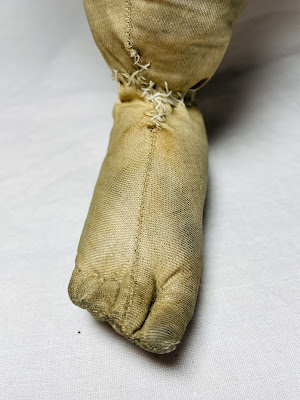Meet the fabulous Miss Zelda!
Here's how Zelda got her name: The UFDC Facebook group has an alphabet sharing format and they are on Z so it inspired me to find a Z name. Zelda means strong (a German short of Griselda) and in Yiddish means happy/blessed. I was tickled pink when I received her, and Valentine's Day is coming up!
I bought this doll because there were enough features to the doll that were reminiscent of an Izannah Walker doll that I wanted to see her in person. I took a chance because I could only see the fully dressed doll and its face and none of the construction underneath. I didn't even know if the back of her head would be there! Lordamercy! I'm glad I bought her though, because she is GREAT.
I photographed an early Izannah Walker doll in 2013 at James Julia auctions. The eyes were flatter, and not as 3D modeled as later dolls. Zelda's eyes reminded me a bit of that doll and that's why I bought her. I wanted to see her in person. But there the similarity in the face ends.
Zelda is not an Izannah Walker doll. The hands are extremely similar although the thumb is not separately attached as they would be in Izannah dolls. The bare feet are also similar to a barefoot Izannah Walker doll. But that type of foot design was widely used amongst various types of dolls in the 19th century. The painted stockinette face is interesting, with a stitched joining at the top. But this doll doesn't have a back middle seam that Izannah Walker dolls do. This doll's stockinette goes all the way down over the neck area to the shoulderplate, while Izannah Walker dolls generally have the stockinette only go as far as the neck, and the shoulder plates are covered with a painted plain woven cloth like muslin. Zelda's face does have a 3D mask feel to it. It appears to have been stiffened but this could have been created by needle-sculpting and then painting the needle sculpted face. I would love to see the underneath, but won't.
Click here to see an example of an Izannah Walker doll that has the stockinette that covers the neck and shoulder plate area. But stockinette over a 3D face structure was pretty common in the later 19th century. Izannahs Walker dolls, Alabama Baby Dolls, Martha Chase Dolls, Philadelphia Shephard Babies, and numerous other one of a kind dolls share this feature. Here is an interesting lady doll with similar construction said to be from Lancaster County, PA which auctioned at Skinner's some years ago can be found at this link: https://www.skinnerinc.com//auctions/2585B/lots/151
Zelda *might* have been assembled of parts from various dolls ages and ages ago? But I don't think so. This doll could have been made by someone who had seen Izannah Walker dolls and was inspired by them. Maybe a generation later someone tried to recreate a beloved doll for their child, but used an entirely different body. The thread joining stockinette to body appears to be older. I blacklighted this doll and don't see any later painting.
I have found another doll that is extremely similar, so perhaps this was a cottage industry dollmaker? Here are two images from Pinterest which don't lead to any site to give attribution. If you know of the site, please let me know. Or if you are the owner of the doll below, please contact me so we can compare construction. This doll in the images below has the same barely indicated ears like Zelda has, as well as a similar face structure and joining of stockinette. This doll in blue has less paint loss but a similar feel of expression and construction around the mouth and nose and the painting of the eyes.
 |
The body style is interesting. Here is a post on MAIDA Today of other antique dolls with a similar design. This froggy type of body usually dates to the last quarter of the 19th century. I think there was a body pattern that was sold commercially and people finished it as they saw fit, because the arms and feet are pretty different. As patterns were shared amongst women who sewed, dolls of this type could have been made later as well. This pattern of Zelda is a little different, as the top of the thighs is gathered (and she has a stitched belly button)
My guess is this doll was made in the 1890's, if I assume this clothing is original to the doll (and I feel like it might be). The bonnet style is 1890's to turn of the century. The bonnet could have been added later, OR the doll could have been made later and fitted with a child's old clothing. The clothing fits her perfectly.
She's a fun doll and I'm going to keep her for a while. In fact, she's a winner because she came with a blue ribbon! The International Doll Association was a doll club formed in Nebraska in 1963 as the "International Doll Club", became the "International Doll Association" in 1973, and then dissolved in 1977.
Here are more images of Zelda, in no particular order.
The body pattern has no joints for sitting:
The hands are very similar to Izannah Walker's hands but the thumb is not separately attached. It's interesting that one hand is cut with the grain going up and down in the directions of the fingers, and the other hand the hand is cut across the bias of the grain.









































1 comment:
What a wonderful doll and a great set of study pictures showing all details. Thank you Dixie for sharing Zelda.
Post a Comment